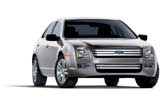Recent Articles
Popular Makes
Body Types
IIHS Rates Fusion Poor in Side Test
Sedan scores Marginal and Acceptable in rear and front testing

Ford’s plan to win back buyers with its new Fusion sedan suffered a potential major setback last week, when the Insurance Institute of Highway Safety (IIHS) gave the sedan a Poor grade in its side crash protection test, a Marginal rating for rear crash protection and an Acceptable rating for its frontal offset test. The results also include the Mercury Milan. "The Fusion is a disappointment because it's a brand new design," said Institute president Adrian Lund. "Ford has done a good job with some other recent models, but the Fusion is at the back of the pack among midsize cars for overall safety performance." In addition to the side impact and rear crash tests, the Fusion is one of just two sedans (Dodge Stratus/Chrysler Sebring) that did not earn the Institute’s highest rating for frontal offset crash protection. But it’s the side test where the Fusion failed to protect occupants most, however: According to the Institute, the driver dummy inside the Fusion without side airbags recorded serious head injuries, rib fractures and the likelihood of a fractured pelvis. In an e-mail, Ford safety spokesperson Daniel Jarvis indicated that Ford will ask the IIHS to test another Fusion with side airbags and side curtain airbags “We expect (the Fusion) will earn higher test ratings with that standard equipment,” wrote Jarvis. Jarvis also noted that the Fusion meets all Federal Motor Vehicle Safety standards, and that later this year, Ford will offer the Fusion with side airbags and air curtains as standard equipment. As per their policy, the Institute conducted the test without side airbags because currently, they are offered only as optional equipment on the Fusion. "Usually when an automaker doesn't ask for the optional test, we presume it means the side airbags wouldn't help much to improve the car's rating," said Lund. "But now that Ford has requested a second test, so the Fusion with side airbags may earn a better rating than poor.” In the Institute’s frontal offset test, the Fusion gained a rating of “Acceptable,” and Lund said that while that was not a bad result, it was “not competitive with other cars in its class.” "Nearly every car now earns good ratings in our frontal test," said Lund. "Based on this car's side and rear evaluations along with its acceptable frontal rating, the Fusion is the lowest rated moderately priced midsize car we've evaluated." The Institute’s testing covers Fusion sedans built after January, 2006. According to Lund, at that time a structure was added below the accelerator pedal in order to reduce injury risk to the right leg and foot in frontal offset crashes. It didn’t work. “Forces recorded on the dummy's right leg were high, and a metal pin broke in the dummy's ankle,” said Lund. “Ford is doing more research to find a solution and has indicated it will ask the Institute to retest the Fusion for frontal crash performance later this year." Lund pointed out that the side structure of the Fusion held up reasonably well in the crash test, and that the car’s structural rating of “acceptable” was better than some other midsize models tested by the Institute. Another positive, according to Lund, included “reasonably good” protection in the rear seat. The head of the dummy in the rear seat struck the pillar behind the rear door, an area required by federal standard to provide protection for an occupant's head.
How the IIHS tests vehicles
The Institute's frontal crashworthiness evaluations are based on results of frontal offset crash tests at 40 mph. Each vehicle's overall evaluation is based on measurements of intrusion into the occupant compartment, injury measures from a Hybrid III dummy in the driver seat, and analysis of slow-motion film to assess how well the restraint system controlled dummy movement during the test.
Each vehicle's overall side evaluation is based on performance in a crash test in which the side of the vehicle is struck by a barrier moving at 31 mph and representing the front end of a pickup or SUV. Ratings reflect injury measures recorded on two instrumented SID-IIs dummies, assessment of head protection countermeasures, and the vehicle's structural performance during the impact. Injury measures obtained from the two dummies, one in the driver seat and the other in the rear seat behind the driver, are used to determine the likelihood that the driver and/or passenger in a real-world crash would have sustained serious injury to various body regions. The movements and contacts of the dummies' heads during the crash also are evaluated. Structural performance is based on measurements indicating the amount of B-pillar intrusion into the occupant compartment. Rear crash protection is rated according to a two-step procedure. Starting points for the ratings are measurements of head restraint geometry — the height of a restraint and its horizontal distance behind the back of the head of an average-size man. Seats with good or acceptable restraint geometry are tested dynamically using a dummy that measures forces on the neck. This test simulates a collision in which a stationary vehicle is struck in the rear at 20 mph. Seats without good or acceptable geometry are rated poor overall because they cannot be positioned to protect many people.
Photos by Brian Chee and courtesy of Ford Motor Co.
